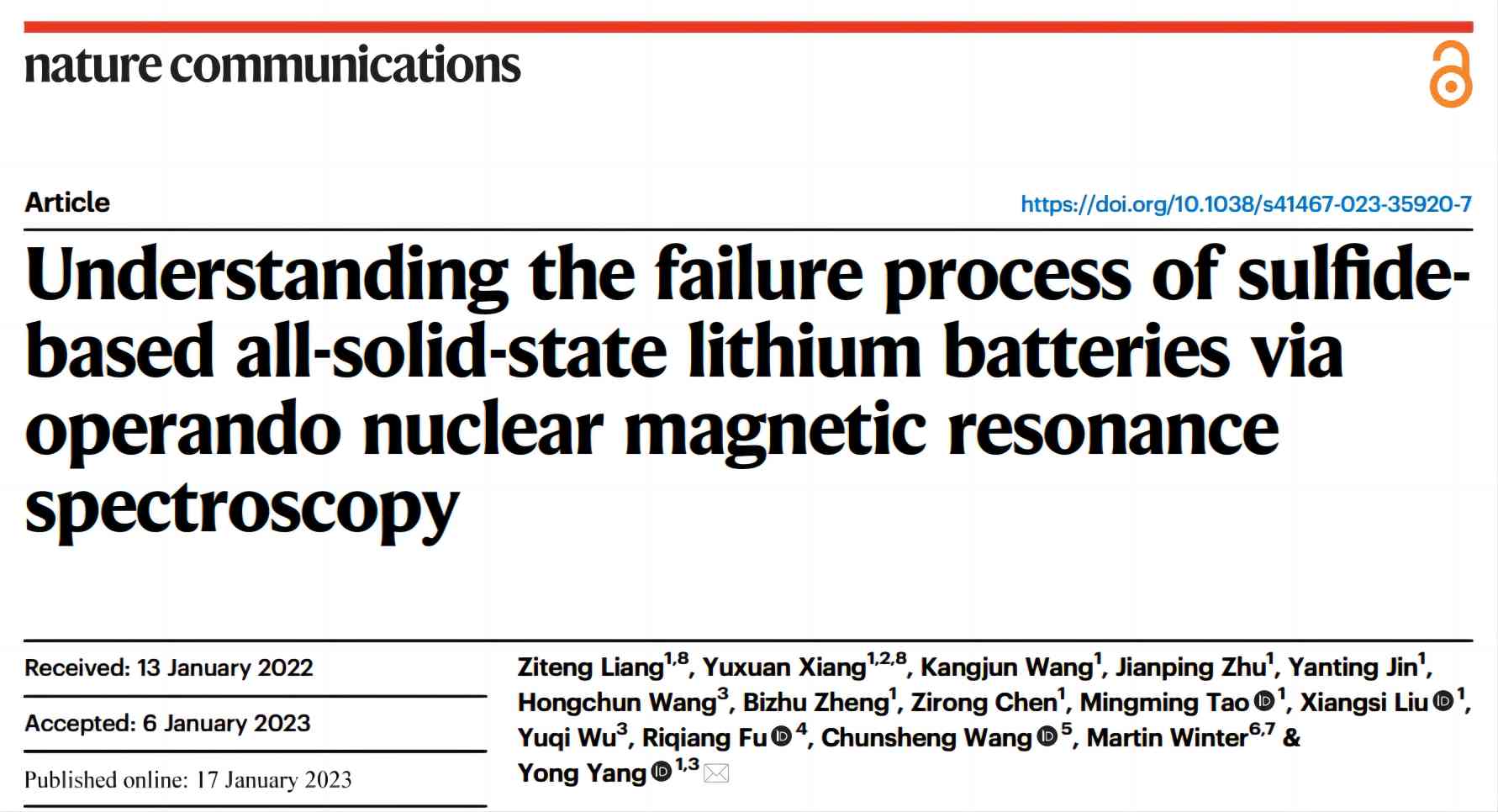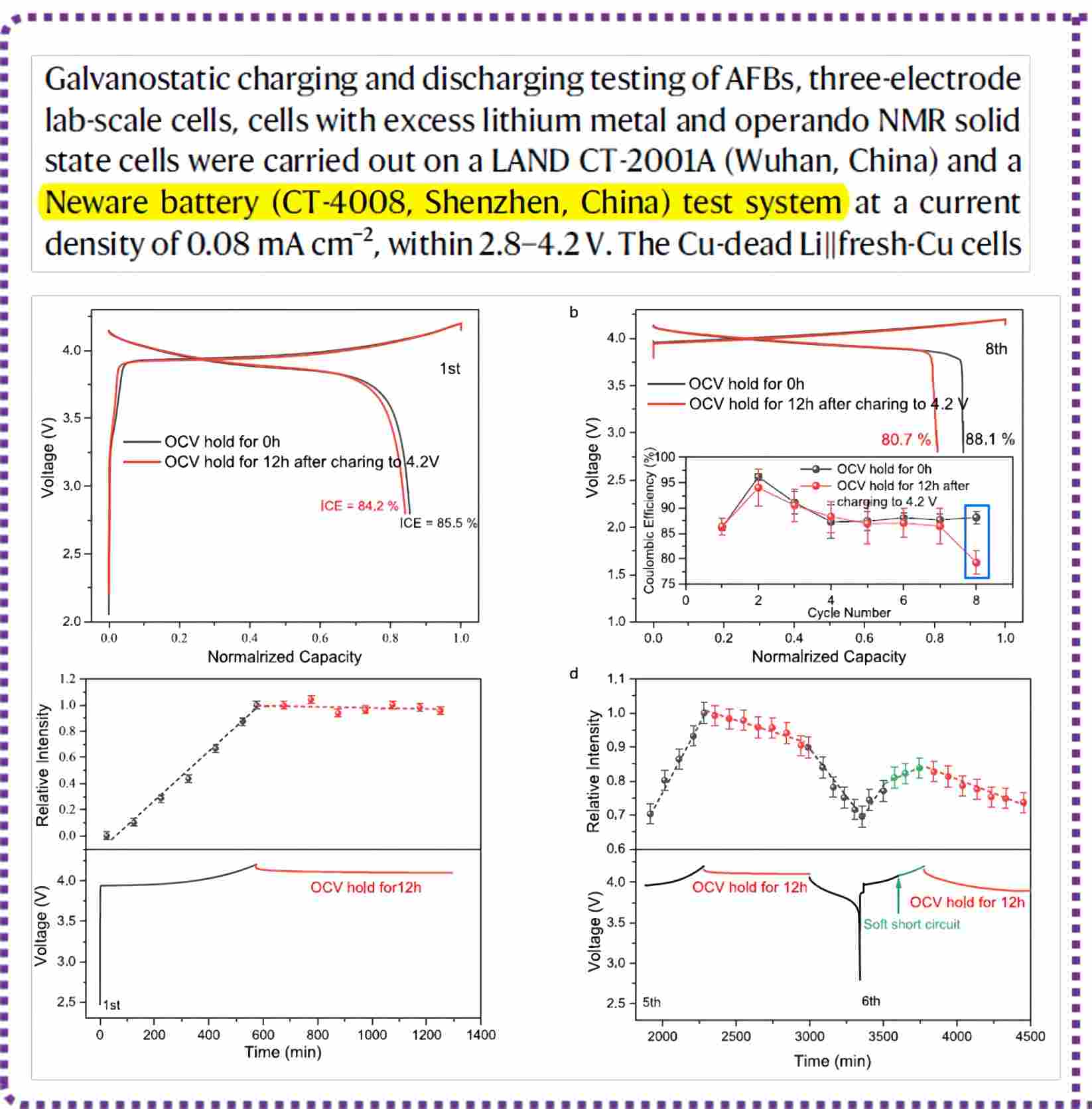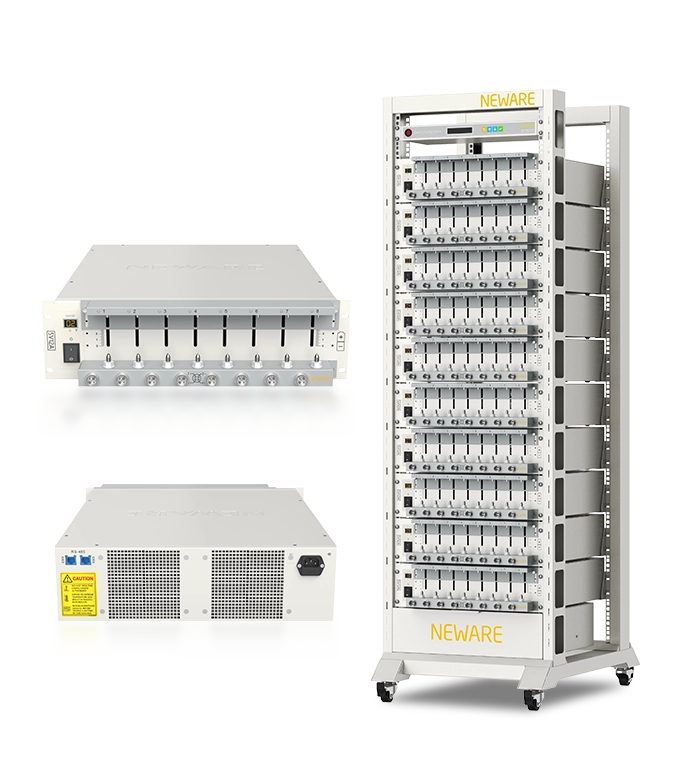NEWARE battery tester is capable of meeting the testing and research needs for all types of batteries. Below is an introduction to the collaborative case studies of NEWARE battery tester in battery research.
Title of the Paper:Understanding the failure process of sulfide-based all-solid-state lithium batteries via operando nuclear magnetic resonance spectroscopy
First author: Ziteng Liang (Xiamen university)
Co-First author: Yuxuan Xiang (Xiamen university)
Corresponding author: Yong Yang (Xiamen university)

Sulfide-based all-solid-state lithium metal batteries have attracted significant attention from both industry and academia due to their potential for achieving high energy density and high safety. However, the cycling performance of lithium-negative-type all-solid-state lithium metal batteries is limited by the continuous generation of non-active lithium during charge-discharge cycles. The non-active lithium consists of two parts: (1) non-active metallic lithium (also known as "dead lithium"), which is caused by uneven lithium dissolution leading to electron-ion pathway interruption, and (2) non-active lithium-containing compounds, which are formed at the interface (electro)chemical reactions between the lithium metal anode and the solid-state electrolyte. The presence of non-active lithium significantly affects the electrochemical performance of the battery. Therefore, accurately quantifying these two types of non-active lithium during the battery cycling process is crucial for understanding the failure process of all-solid-state lithium metal batteries.
Based on this, the research team led by Yong Yang from Xiamen University, for the first time, utilized in situ solid-state nuclear magnetic resonance (NMR) technology to analyze the failure mechanisms of lithium metal anodes in different sulfide-based all-solid-state lithium batteries. Through quantitative studies of non-active lithium in the system, they revealed the formation mechanisms of the two types of dead lithium in all-solid-state batteries. In addition, they also investigated the corrosion issue of the lithium metal anode in all-solid-state lithium metal batteries and clarified the relationship between corrosion rate and lithium metal morphology. This work deepens the understanding of the failure mechanisms of all-solid-state lithium metal batteries and provides important guidance for their further development. The work was published in the top-tier international journal Nature Communications, with Ziteng Liang and Yuxuan Xiang as co-first authors.

In the paper, it can be seen that some of the electrochemical performance was tested using NEWARE's battery testing equipment (CT-4008). This equipment is a star product in the CT-4000 series, which not only includes testing devices for button batteries but also features a cell charge-discharge testing cabinet designed for square pouch batteries and other specific requirements. The testing cabinet offers different charge-discharge modes to meet your testing needs with just one click.

NEWARE CT-4008Q-5V12A-S1 battery tester features four highly precise testing ranges: Range 1 from 0.5mA to 100mA, Range 2 from 100mA to 500mA, Range 3 from 500mA to 6A, and Range 4 from 6A to 12A, with a current accuracy of ±0.02% F.S. and a recording frequency of 10Hz. Its sampling time is set at 100ms, with a minimum pulse width of 500ms. This product is distinctively designed with a modular approach, wherein each unit contains 8 channels, each capable of independent data acquisition and programming, supporting up to 254 editable lines for extensive testing procedures. Specifically engineered with integrated probes for cylindrical batteries, the NEWARE battery tester facilitates height adjustments to cater to various sizes of cylindrical batteries, ensuring versatility in testing. It is capable of conducting a wide range of tests, including cycle life tests, rate charging/discharging tests, pulse simulation tests, GITT tests, DCIR tests, and enables the analysis of dQ/dV differential capacity curves, making it a comprehensive solution for battery testing requirements.
BTS (Battery test system) is a next generation battery performance testing software developed by NEWARE through years of continuous innovation to meet market demands. This system is an upgraded version based on the network version of BTS host software and supports measurement functions for individual cell voltage and temperature, DCIR (Direct current internal resistance) measurement, pulse steps, SIM steps, constant power charging, etc. It can perfectly accomplish battery sorting, grouping, and curve comparison functions.
NEWARE dedicated to providing support for global battery manufacturers, electric vehicle producers, energy storage battery manufacturers, as well as enterprises, national quality inspection departments, universities, and research institutions.
-Offering high-performance battery testing systems, formation and grading systems, environmental test chambers, and automation equipment.
-Providing system services (NEWARE LabTech AI + NEWARE Store BI), LIMS+MES.
-Providing a global service network, achieving timely response.




The lab focuses on solid-state battery research to overcome traditional lithium batteries' safety and energy density issues, supporting environmental sustainability. It develops innovative solid-state electrolytes, refines electrode materials, and investigates ion transfer and interface stability to revolutionize battery technology.

The electric vehicle battery industry is rapidly developing, focusing on technological innovation, market competition, and sustainability. Research hotspots include solid-state batteries, new types of electrolytes, BMS optimization, and recycling technologies. The environmental adaptability, safety, and economic viability of batteries are key research areas, and the industry is expected to undergo more innovation and transformation.

We specialize in battery preparation technology research, focusing on overcoming existing energy storage challenges by innovating in electrode materials, battery chemistry, and manufacturing processes to improve performance, enhance safety, and reduce costs. Sustainability and recycling technologies for batteries are also emphasized to mitigate environmental impacts and foster the growth of green energy.